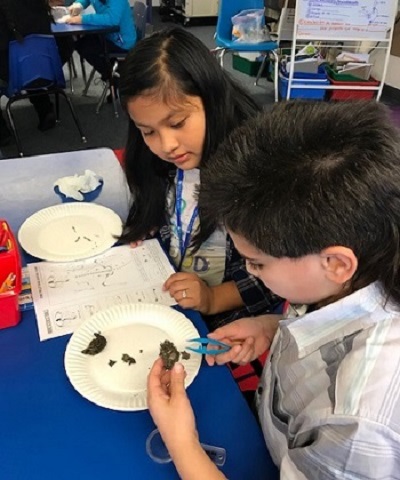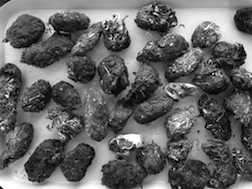About Pellet Map Project
Goals of the project

SMILE students trying their hand at pellet dissection
The major goal of Pellet Map Project is to produce high-quality distribution data on small mammals in the Western United States, and make that data available for both academic and non-academic researchers. Climate change patterns are having wide-ranging effects on species' distributions across the globe. We aim to investigate how small mammals are responding to these patterns. Having high-resolution data on species' ranges is important for determining a baseline for future studies to compare against. This will allow quantitative assessment of climate change models now in place. Furthermore, we can use historical records and paleontological evidence to assess how species ranges have shifted from the recent and distant past. Understanding how species' distributions have changed over time will better allow us to predict how they might change in the future.
A second goal of Pellet Map Project is to engage the public in awareness of the natural world around us. We have created a collaboration with SMILE (Science and Math Investigative Learning Experiences), a precollege program at Oregon State University aimed at providing learning opportunities for under represented groups, and teacher development in the STEM fields. This collaboration will allow the next generation of ecologists to participate in research going on where they live.
Pellet Map to date:
- 359 Students
- 11 Schools
- 230 Pellets picked
- 1,145 Bones identified
- 21 Species identified

Willamina Elementary students eating like owls (consuming mouse-shaped
chocolates!)
What is a raptor pellet?
Pellets from raptors and other bird species are the undigested material regurgitated after consuming a meal. You might remember dissecting these in high school biology class. They can range in size from a few centimeters to a few inches depending on the species. Many large raptors swallow their prey whole. The undigested hair and bone gets compacted into a small pellet in the bird's gizzard, and is then ejected back through the esophagus and out of the mouth. Small birds of prey that are unable to swallow their food whole often tear their prey into smaller pieces that are more easily consumed. Pellets from these birds can still contain small bones that are useful for identification. Most raptors produce 1 to 2 pellets per day, which can have as many as 6 individual prey items in them. The prey remains can be easily "dissected" from the pellets and identified to species.
Why use raptor pellets?

Raptor pellets represent a naturally occurring accumulation of prey remains. Paleontologists often refer to these accumulations as "death assemblages". Death assemblages offer researchers an efficient means at obtaining a large quantity of data with minimal effort. We let the raptors due the work for us, saving valuable time and resources. But how well do these accumulations actually represent the mammal communities from which they are drawn? Evidence suggests that owls living in desert landscapes do sample from the living community with a high degree of fidelity for the relative abundance of species. Given that raptor diets vary greatly according to diurnal or nocturnal patterns, the potential to create an accurate picture of the small mammal communities by using pellets from multiple species is great. More research is needed on the ability to accurately quantify faunal communities from raptor pellets, but the current evidence points towards a high degree of similarity. In combination with other methods for sampling species, pellet analysis can provide a robust measure of species distributions.

Another reason to use raptor pellets is that the skeletal remains hold valuable ecological information that would not be accessible from live animals. Therefore, this method offers a unique, non-invasive technique by which researchers can study small mammal communities. Aside from simply providing data on species ranges, or the relative abundances within a community, pellet remains allow us to investigate other ecologically important parameters, such as diet and physiology. Biochemical analysis of bone collagen from pellet remains can inform our understanding of trophic response in a small mammal community across space and time. Morphological analysis of the bones can also tell us about the physiological state of an animal at the time of death. Furthermore, DNA extraction of bone material from pellets has been proven to be a reliable source of genetic data, allowing for studies of population dynamics.